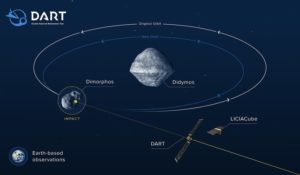The NASA/ESA Hubble Space Telescope captured a series of photographs of the rapid changes to the asteroid Dimorphos when it was deliberately struck by a 545-kilogram spacecraft on September 26, 2022. The main goal of NASA’s mission, called DART (Double Asteroid Redirection Test), is to test the ability to change the trajectory of an asteroid as it orbits its larger companion asteroid.
While the Dimorphos asteroid does not pose a threat to Earth, the mission data could help researchers learn how to potentially change the asteroid’s path away from Earth if that is ever needed.
The resulting data from the impact shows surprising and remarkable changes as dust and pieces of debris were thrown into space by the destroyed asteroid. Slamming into the asteroid at a speed of 21,000 kilometers per hour, the DART ship threw more than 900,000 kilograms of dust from the asteroid.
Hubble Space Telescope footage shows three overlapping phases of the crash’s aftermath: the formation of an ejection cone, a spiraling vortex of debris trapped along the asteroid’s orbit around a companion asteroid, and a tail being swept behind the asteroid by the pressure of sunlight.
The first photo after the impact was taken two hours after the event. The debris flies away from the asteroid, approaching at over four miles per hour (fast enough to escape the asteroid’s gravitational pull so it doesn’t fall back onto the asteroid). The ejecta form a mostly hollow cone with long fibrous filaments.
Approximately 17 hours after the collision, the debris pattern entered the second stage. Dynamic interactions within the binary system began to distort the cone-shaped ejecta pattern. The most noticeable structures are the pinwheel-shaped rotating elements. The pinwheel is associated with the gravitational pull of the companion asteroid.
Hubble then records the debris being swept back into the comet-like tail by the pressure of sunlight on the tiny dust particles. This stretches out into a debris chain where the lightest particles travel fastest and furthest from the asteroid. Hubble also recorded the tail splitting in two within a few days.
ESA’s Hera mission, due to launch in October 2024, will take a detailed survey of the target asteroid Dimorphos after the impact. Hera will turn the large-scale experiment into a well-researched and replicable planetary defense technique that can one day be used for real.
NASA and ESA worked together in the early 2000s to develop asteroid monitoring systems, but recognized a missing link in the chain between identifying an asteroid threat and how to eliminate that threat.
In response, NASA oversaw the DART mission, while ESA developed the Hera mission to collect additional data on the impact of DART. With the Hera mission, ESA takes on even greater responsibility for protecting our planet and ensuring it plays a leading role in overall efforts to combat asteroid risks. As the planetary defender’s flagship, Hera receives support from the European Space Security Agency’s Operations Directorate programme.





